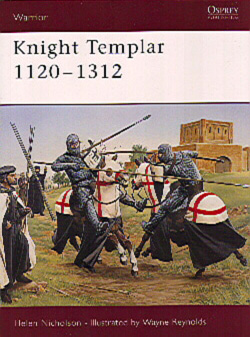

Knight Templar 1120-1312

This book, a volume in Osprey’s large and growing series devoted to military life, is on its publisher’s bestseller list, and deservedly so.
It is aimed, like all of Osprey’s books, more at the “interested amateur” market than at scholars. This does not mean that scholars should ignore it. Written by one of today’s foremost historians of the military orders, Knight Templar presents state-of-the-art scholarship in a swiftly summarized form. It mates a high level of accuracy with an appealing presentation that makes it useful for interested amateurs and undergraduates, and yet also profitable for more advanced students of the Templars. It is difficult to put such a bird’s-eye view of a complex subject together in a way that makes it appealing to the public and yet satisfies the demands of professional historians. Nicholson has succeeded in the task.
The book has a number of black-and-white photos, maps and sketches, as well as eight specially-commissioned color paintings, executed with careful attention to historical accuracy and accompanied, as is usual for Osprey books, by detailed discussions of the scenes and items depicted. It also offers a chronology; a glossary; and an up-to-date bibliography of general studies, major primary sources translated into English, primary sources in other languages, and collections of essays.
Nicholson situates the Order of the Temple firmly in its medieval Christian milieu (where it belongs, despite what some best-selling novelists argue), and takes the time to sketch what that means, which is helpful for those readers with little understanding of historical Christianity. The text covers the Templars’ recruitment and admission practices; Christian beliefs and spiritual lives; training and daily routines; appearance, equipment and living conditions; and experiences in battle. It ends with a short section on Templar-related museums and re-enactment groups.
Nicholson has included many anecdotes from primary sources, well-chosen both to illustrate her points and also to provide vivid images of Templar life, like the story which Jacques de Vitry tells of the knight who bade farewell to his horse Blackie before battle, thanking the animal for its faithful service and telling it that today it would carry him to heaven (20-21). The facts are further brought to life by Nicholson’s well-informed imagination, noting not just what statutes say, but also what they imply, or what we can infer beyond available evidence. This willingness to speculate within the boundaries of what is historically reasonable makes the book especially pleasurable to read.
Those with deeper interest in the subject will find that interest repeatedly piqued by statements that they may wish had been footnoted to allow further exploration. But this is an omission necessary to this sort of book. It might also have been useful to include a section countering the rampant mythmaking that plagues so many popular works on the Templars, but given the constraints of space in this short book, it was probably better to focus on what we really know, and hope that truth drives out distorted fiction. In any case, Nicholson has provided just such a refutation elsewhere, in the final chapter of her Knights Templar: a new history, Sutton, 2001.
All in all, an excellent example of how to present solid, complex history in an engaging way to a wide audience.
